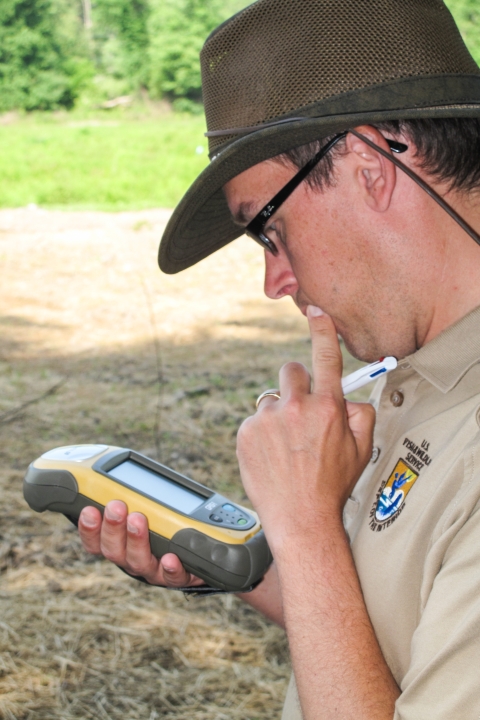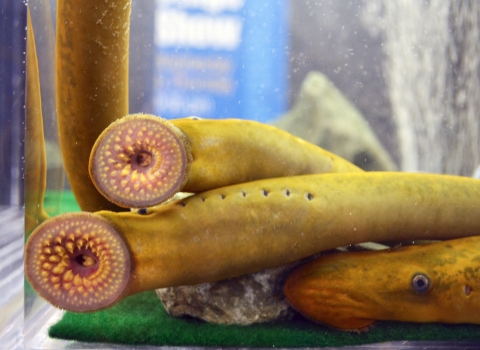On November 24, 1983, a Cessna 414A left Chicago en route to Sylva, North Carolina, a small town just south of the Blue Ridge Parkway. The plane’s last radar contact showed an altitude of 6,100 feet. About a mile later, at an altitude of about 6,000 feet, it crashed into the ridge between Waterrock Knob and Mount Lynn Lowery, in North Carolina’s Plott Balsam Mountains — the last mountain range before descending to Sylva. More than 35 years later, U.S. Fish and Wildlife Service biologist Mark Endries came across the site while helping chart a course for restoring mountain top forests.
Forty-nine of the highest fifty peaks in the Eastern United States are in the Southern Appalachians. These peaks are found in a handful of mountain ranges, including the Plott Balsams. The tops of these ranges are home to cold-weather habitats like northern hardwood and spruce-fir forests, habitats unlike anything else in the South, and isolated from anything similar by hundreds of miles of lower elevation. For this, these areas are often referred to as sky islands.
“Due to their high elevation, these areas are home to wildlife you would expect to find much further north,” said Service biologist Sue Cameron. “But beyond those disjunct species, these areas are also home to plants and animals found nowhere else in the world, like the endangered spruce-fir moss spider, making these peaks important for global biodiversity.”
These sky islands are important as habitat for a number of threatened and endangered plants and animals. Cliff faces are home to spreading avens and the rock gnome lichen, one of only two lichens on the endangered species list. The moss mats on the forest floor are home to the endangered spruce-fir moss spider. Those red spruce trees are home to the endangered Carolina northern flying squirrel.
Applying technology to guide conservation
Mark Endries takes a reading from a GPS unit. Photo by Gary Peeples, USFWS.
Though adept at bush-whacking and climbing through these forests, Endries’s professional expertise comes with a keyboard at his fingertips and Geographic Information System software running in front of him. Geographic Information System, or GIS, is computer software enabling someone to manage, analyze, and use geographic data. At its simplest, working with a GIS lets you lay layers of information on top of each other to make a map.
For example, you start with the outlines of the 50 states. Then you add interstates, then cities, resulting in a map showing how U.S. cities are connected by interstates. At a more complicated level, you can analyze data and display something novel on your map. And that was how Endries began applying GIS technology to sky island conservation.
The Carolina northern flying squirrel has been on the endangered species list since 1985, and is found only on the sky islands of Southern Appalachia. Thanks to years of monitoring, biologists knew where they could expect to find the squirrel, but it would be helpful if they had a more thorough idea of the areas the squirrel might use. Working from known squirrel locations, Endries used GIS software to parse through the geographic data — like soil type, elevation, even the direction a mountain slope faces — to see which variables were key to the squirrel’s presence. Using those variables, he mapped where biologists were likely to find the squirrel, helping guide efforts to inventory and monitor the squirrels, and feed decisions on where to protect and restore habitat.
Charting a course for spruce restoration
Shortly after Endries took a closer look at squirrel habitat, a broader effort took root in the high-elevation conservation community. A century and a half ago, red spruce was far more abundant in these high elevation areas. Excessive logging, followed by widespread forest fires in the late 19th and early 20th centuries, altered the nature of southern Appalachian forests for decades, including significantly reducing the extent of high elevation spruce forests. The Southern Appalachian Spruce Restoration Initiative, or SASRI, was formed in 2013 to restore those spruce forests.
“I was meeting with the staff of the Cherokee National Forest, spruce restoration came up as a priority, and we realized restoring spruce was much harder than we thought it would be,” said Katherine Medlock of The Nature Conservancy. “There were fundamental questions that didn’t have answers, like where to get appropriate trees and when and how to plant them. We heard a successful spruce restoration effort was underway in the central Appalachians. We learned from their efforts, convened like-minded people here in the Southern Appalachians, and SASRI was born.”
A key step in deciding where to plant new spruce trees was getting a grasp of where red spruce used to grow and where it currently grows.
“We compiled all known red spruce data, including digitizing a lot of paper maps, one of which was more than 100 years old,” said Endries. “We realized the data were more generalized than we were hoping for, and its use in helping guide on-the-ground restoration efforts was limited.”
There was little they could do to improve the resolution of historic data, but something could be done to improve the understanding of what is currently on the ground. Medlock was involved in a Tennessee effort to map hemlock density, so why not do the same for red spruce?
Working from aerial photography from the state of North Carolina, Cornell University’s Nick Hollingshead mapped the extent and density of red spruce in much of the Southern Appalachians, even getting an idea of spruce in the understory. But how did the computer exercise compare with what’s on the ground?
Endries connected with Asheville-based non-profit WildSouth to form a cadre of volunteers to visit random sites across the sky islands and collect data to compare against Hollingshead’s computer-generated outcome. He even set it up so the volunteers could use a mobile app to photograph sites, enter a description of what they saw, link it with their latitude and longitude, then upload everything to a database, from which Endries could download to his office computer. In the end, Endries and the volunteers visited more than 800 sites double-checking the data, taking them through some of the most rugged terrain in the Southern Appalachians.
“The reality of getting to randomly selected spots in this terrain was a lot different than looking at them on a map,” said Endries. It was during this ground-truthing Endries came across the Cessna crash site in the Plott Balsams and another plane crash site in the Black Mountains, near Mount Mitchell. And despite his bushwhacking taking him to places he felt no one has ever visited, he still saw the all-too-common hand of humanity — trash. For the project, the field effort validated the computer modeling effort.
“It even did a pretty remarkable job of telling what was in the understory, which blows my mind a bit,” said Endries.
Doing one better by the squirrel
Now Endries is working with Virginia Tech researcher Cordie Diggins to dig deeper into modeling Carolina northern flying squirrel habitat. The first step is to develop a map of spruce, guided by Hollingshead’s work, but turning out an even finer-resolution product — getting down to individual trees. To get to this resolution, they’ll use aerial photography imagery from the U.S. Department of Agriculture that divides the light spectrum into four bands of data: red, green, blue, and near infrared. Each plant has a distinct signature based on how it reflects these wavelengths. The biologists plug in information from Hollingshead’s work to train the computer to recognize the color signature of red spruce and put the computer to work finding occurrences of red spruce across the southern Appalachians. The high-resolution map will then be plugged into models of where the squirrels should be found, thus providing the highest known resolution map of Carolina northern flying squirrel habitat.
“This mapping effort is going to be key as we move ahead with efforts to restore spruce forests,” said Cameron. “It will really allow us to hone in on where we want to restore red spruce, increasing the efficiency and effectiveness of our efforts to recover the squirrel.”





